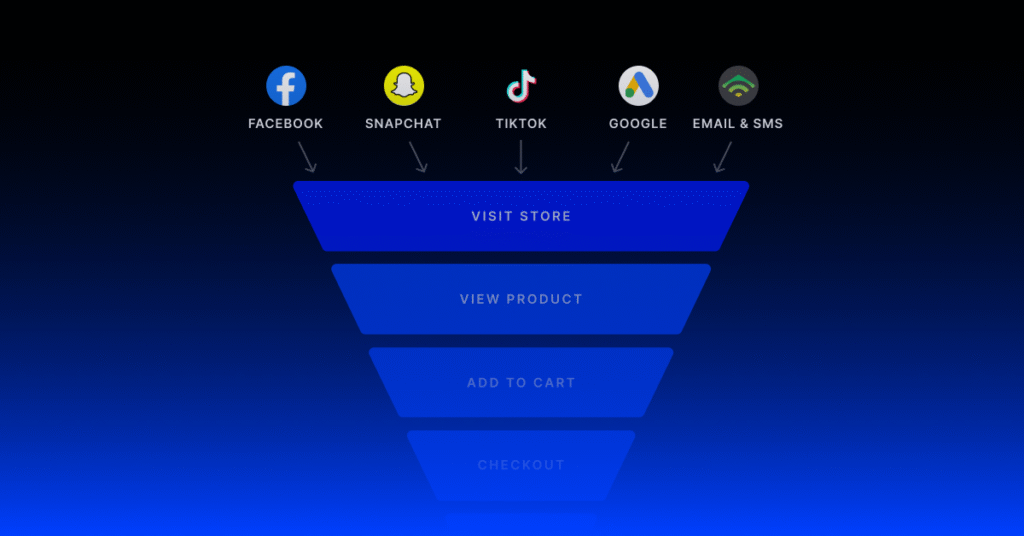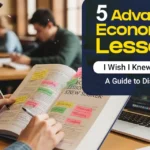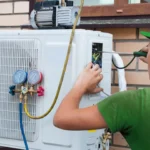Shoppers expect personalized, seamless, and faster buying journeys. But most e-commerce businesses face a persistent challenge: customers drop off before reaching the checkout. Cart abandonment rates remain high, and converting visitors into loyal buyers is harder than ever. That’s where optimizing the ecommerce funnel becomes crucial.
Growth teams can’t rely only on traffic anymore. The real focus must be on improving conversion efficiency at every stage. From awareness to retention, each interaction matters. Smart brands are rethinking their funnels using AI, intent-based recommendations, and data-driven personalization to increase revenue and keep customers coming back.
This blog explores proven strategies to optimize every stage of the funnel in 2025, backed by consumer behavior insights and advanced technologies.
Understanding the E-Commerce Funnel and Its Stages
The e-commerce funnel represents the entire customer journey from discovering your brand to becoming a repeat buyer. Optimizing each stage ensures fewer drop-offs, higher conversions, and stronger customer relationships.
Key Stages of the E-Commerce Funnel
| Stage | Objective | Tactics That Work in 2025 |
| Awareness | Attract the right audience | Personalized landing pages, targeted ads, and influencer partnerships |
| Consideration | Engage and educate buyers | Smart product recommendations, comparison tools, and reviews |
| Decision | Drive high-intent purchases | One-click checkout, exit-intent offers, and limited-time discounts |
| Retention | Keep customers coming back | Loyalty programs, post-purchase upselling, personalized campaigns |
Modern funnels aren’t linear anymore. Customers often move back and forth between stages based on offers, preferences, and competitive options. Brands must design journeys that adapt in real time.
Common Bottlenecks That Hurt Funnel Conversions
Many brands drive traffic successfully but fail to convert visitors into buyers. This usually happens because friction exists at multiple stages.
Key Issues Affecting Conversions
- Complex site structures: Too many clicks before checkout cause visitors to drop off.
- Slow load speeds: Pages taking longer than three seconds lose impatient buyers.
- Generic recommendations: Showing irrelevant products reduces engagement and trust.
- Cluttered checkouts: Multiple form fields and unnecessary steps lead to high cart abandonment.
- Poor retention strategies: Neglecting returning customers hurts repeat purchases.
How to Diagnose Funnel Leaks
Tracking micro-conversions and behavior signals helps you identify exactly where users drop off:
| Funnel Stage | Key Metrics to Track |
| Awareness | Bounce rate, CTR on ads, and landing page dwell time |
| Consideration | Product page interactions, wishlist additions, clicks on recommendations |
| Decision | Cart abandonment rates, payment drop-offs, and failed transactions |
| Retention | Repeat purchase rates, subscription churn, and email open rates |
Identifying these bottlenecks early lets you redesign the funnel experience intelligently.
Personalizing the Funnel Experience With AI
In 2025, personalization has evolved from basic recommendations to context-driven, AI-powered experiences. Shoppers expect curated journeys based on their preferences, browsing history, and intent.
How AI Personalization Works
- Predicts user intent using historical purchase data and browsing patterns
- Recommends relevant products dynamically, based on micro-behaviors
- Customizes messaging for every stage, from discovery to checkout
- Optimizes timing for discounts, reminders, and upsell triggers
Examples of Smart AI-Driven Personalization
- Showing dynamic product bundles based on previous orders
- Sending back-in-stock alerts for saved products
- Using geo-targeted promotions for local buyers
- Offering tiered discounts based on loyalty status
AI transforms the funnel from static to adaptive, boosting engagement and average order value (AOV).
Using Behavioral Nudges to Improve Funnel Efficiency
Behavioral science plays a huge role in optimizing conversions. Subtle cues influence decision-making and help guide buyers down the funnel.
Effective Behavioral Nudges for 2025
- Scarcity triggers: “Only 3 left in stock” encourages quicker action.
- Social proof: “4,300 shoppers bought this today” builds trust instantly.
- Urgency timers: Countdown clocks during sales drive faster conversions.
- Anchoring discounts: Showing the original price alongside savings highlights value.
These nudges shorten decision cycles and motivate users to act without feeling pressured.
Optimizing Key Stages of the Funnel
Every stage of the funnel demands a tailored approach to reduce friction and maximize engagement.
1. Awareness Stage
- Use intent-driven ad targeting to reach high-potential buyers.
- Personalize landing pages based on campaign source and demographics.
- Incorporate interactive banners and shoppable videos for higher CTRs.
2. Consideration Stage
- Deploy smart product recommendations to surface relevant options.
- Include customer reviews, UGC, and comparison tools to aid decision-making.
- Offer AI-powered chatbots for instant answers to product-related queries.
3. Decision Stage
- Enable one-click checkouts to minimize abandonment.
- Use exit-intent offers like discounts or free shipping to recover buyers.
- Test A/B variations of payment flows to identify the most efficient designs.
4. Retention Stage
- Build personalized loyalty programs based on past purchase behavior.
- Send curated re-engagement emails with tailored product suggestions.
- Create VIP experiences for top spenders with early access to launches.
Predictive Analytics & Intent Scoring
Data-driven brands in 2025 don’t just track conversions — they predict them. Predictive analytics uses machine learning to forecast buying behavior and tailor interventions before a drop-off happens.
Key Applications
- Intent scoring: Identifies high-potential buyers based on browsing depth and product interactions
- Dynamic retargeting: Personalizes ads based on abandoned products or viewed categories
- Inventory alignment: Ensures high-demand products stay stocked during peak periods
- Customer lifetime value (CLV) modeling: Helps prioritize retention strategies for your most profitable buyers
With predictive insights, businesses can act before they lose a customer, not after.
KPIs to Track Funnel Success
Tracking the right KPIs ensures you measure impact, not just activity.
| Funnel Stage | Primary KPI | Why It Matters |
| Awareness | CTR, impressions | Measures ad efficiency and visibility |
| Consideration | Engagement rate, session time | Reveals content and product appeal |
| Decision | Conversion rate, CAC | Tracks cost-effectiveness of acquisition |
| Retention | CLV, repeat purchase rate | Assesses loyalty and revenue growth |
Monitoring these metrics consistently helps fine-tune the funnel for better ROI.
Best Practices for Optimizing Funnels in 2025
Optimizing the e-commerce funnel isn’t about small tweaks anymore — it’s about orchestrating seamless, personalized customer journeys that adapt dynamically at every stage. Here’s a deeper look at the strategies shaping conversions in 2025:
1. Focus on Mobile-First Experiences
With 70%+ of all e-commerce traffic now coming from mobile, a mobile-first approach is no longer optional. Shoppers expect lightning-fast load times, thumb-friendly navigation, and personalized layouts tailored to smaller screens.
- Prioritize mobile-responsive designs that adapt instantly to different devices.
- Streamline forms and inputs to reduce friction on smaller screens.
- Use progressive web apps (PWAs) and accelerated mobile pages (AMP) to improve speed and user experience.
- Ensure seamless cross-device continuity, users should be able to start browsing on their phone and complete the purchase on a laptop without re-entering details.
2. Integrate AI-Powered Recommendations at Every Stage
Consumers don’t want to browse endlessly, they want relevance. AI-driven recommendations personalize the experience based on past behavior, intent, and purchase probability.
- On product pages, suggest complementary items to increase average order value (AOV).
- On checkout screens, showcase cross-sells or bundles based on the current cart.
- In retention campaigns, personalize email and WhatsApp recommendations to win repeat purchases.
By delivering the right product at the right moment, you reduce decision fatigue and drive faster conversions.
3. Test, Learn, and Iterate Continuously
The top-performing brands don’t assume what works; they experiment relentlessly. A/B and multivariate testing let you validate which layouts, messages, and offers move the conversion needle.
- Test headline variations, pricing displays, and product imagery on landing pages.
- Experiment with checkout flows, compare one-page checkouts against multi-step journeys.
- Use AI-based predictive testing to automatically deploy winning variants in real time.
This ongoing refinement ensures your funnel evolves alongside customer expectations.
4. Simplify Checkout Flows for Faster Decision-Making
A complex checkout experience is one of the biggest conversion killers in e-commerce. Streamlining this stage minimizes drop-offs:
- Enable one-click checkouts for returning customers.
- Offer multiple payment options, including UPI, BNPL, wallets, and global gateways.
- Reduce form fields to the essentials fewer steps mean fewer abandoned carts.
- Use auto-fill, saved addresses, and express delivery options to speed up decisions.
The easier it is to complete the purchase, the higher your conversion rates climb.
5. Segment Audiences to Deliver Personalized Campaigns
Generic campaigns no longer work in 2025. Today’s shoppers expect hyper-relevant messaging, and segmentation makes it possible.
- Segment based on demographics, behavior, purchase history, and engagement scores.
- Build unique funnels for first-time visitors, returning shoppers, and VIP customers.
- Tailor discount strategies, loyalty rewards, and retargeting campaigns to maximize ROI per segment.
The better your segmentation, the more aligned your content, offers, and recommendations become, directly impacting conversions and lifetime value.
6. Align Sales and Marketing for Consistency Across Touchpoints
E-commerce conversions often drop when messaging, offers, and customer promises differ across channels. Alignment between marketing and sales ensures a cohesive buying experience:
- Share customer intent data between teams for smarter product targeting.
- Ensure ad campaigns, email nurturing, and sales outreach deliver consistent messaging.
- Leverage a unified CRM to synchronize promotions, discounting strategies, and follow-ups.
When your teams work toward the same metrics, your funnel naturally becomes more efficient and conversion-friendly.
Conclusion
Optimizing the e-commerce funnel in 2025 goes far beyond simply increasing traffic — it’s about creating personalized, frictionless, and intelligent customer journeys that maximize conversions and lifetime value.
Shoppers want speed, relevance, and seamlessness. From AI-driven product recommendations and predictive analytics to behavioral nudges and hyper-personalized retention campaigns, the brands winning today are the ones that anticipate intent instead of reacting to it.
Every stage of the funnel, awareness, consideration, decision, and retention, presents unique opportunities to reduce drop-offs and deepen customer relationships. By combining real-time personalization with data-backed strategies, businesses can convert more visitors into loyal advocates.
The bottom line? Brands that thrive in 2025 are those that:
- Turn insights into intelligent actions
- Deliver relevance at every customer touchpoint
- Make shopping effortless, engaging, and enjoyable
When your funnel adapts to what customers want before they even ask for it, conversions stop being a challenge and start becoming a competitive advantage.






